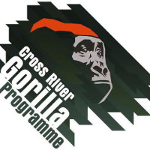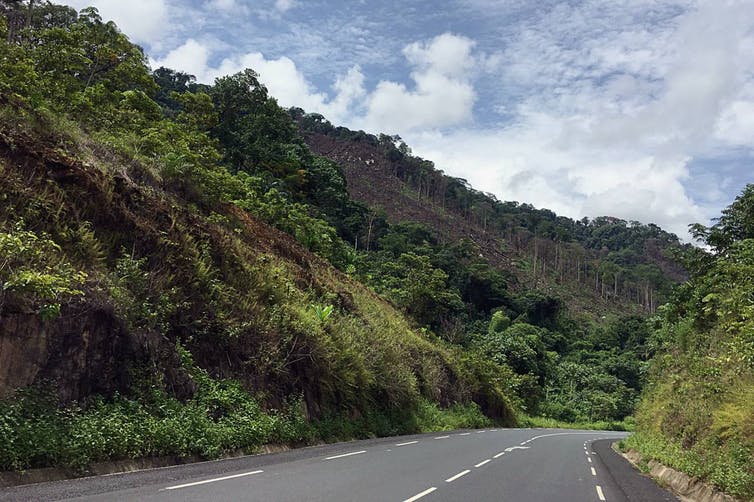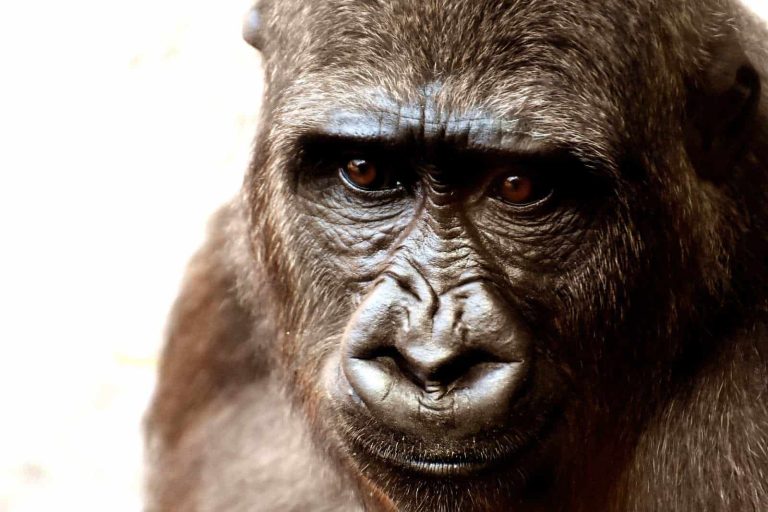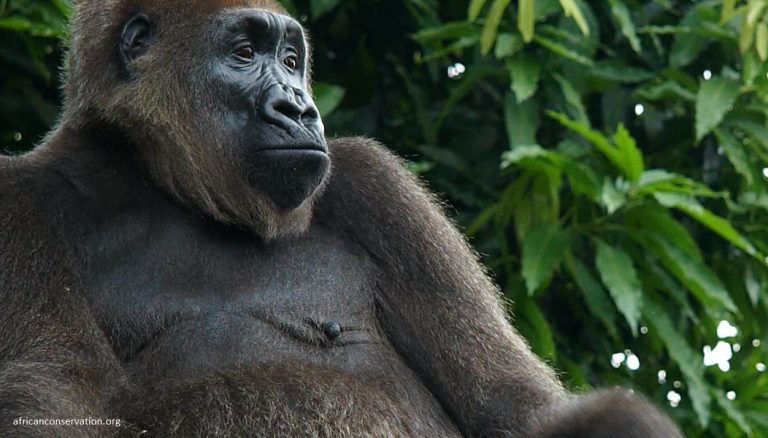An animated look at the impacts of road development on deforestation in South West Cameroon
Deforestation is still increasing exponentially in tropical regions. The forest landscape in Upper Bayang and Manyu Department at large is home to the critically endangered Cross River gorilla in South West Cameroon. Until recently the forest was relatively intact because of its remoteness and inaccessibility, but in 2008 a multinational infrastructure rehabilitation and development project was started.
The Bamenda-Mamfé-Ekok-Abakaliki-Enugu Multinational Road Corridor, which was developed from 2008-2013, connects Cameroon and Nigeria and is a stretch of the Lagos-Mombassa Trans-African Highway. Goal of the new road is to help improve regional integration and living conditions, combat poverty and promote economic growth. The 443 km long road comprises the Cameroonian Bamenda-Mamfe-Ekok road sections (203 km), the Nigerian road sections (240 km), and the border bridge over the Cross River.
While the road brings great social and economic benefits to the local population of 3 million Cameroonians, such as improved transport of people and agricultural products and regional trade, the road has also some inherent side-effects. This includes construction of new houses and expansion or development of new villages along the road. It also includes increased deforestation and forest degradation, because of an increase in illegal logging activities and farm development in the forest, both in areas with and without formal protection.
Road explosion
Road-building and infrastructure development is currently one of the most pressing threats to forests and biodiversity worldwide. The research group of Bill Laurance, Distinguished Research Professor at the James Cook University, recently analysed the relationship between global infrastructure development and deforestation, warning that we are currently living in the most explosive era of infrastructure expansion in human history. This new infrastructure is having severe impacts on many ecosystems and species, especially in previously untouched areas in the tropics.
Also in Africa the last intact rainforests are becoming increasingly fragmented. The main drivers are timber harvesting, agriculture expansion and infrastructure development. Apart from logging, the dark side of roads is that they promote harmful activities including encroachment, illegal poaching, mining, conversion of forest to farms and forest fires.
If we are to conserve these forests, new strategies must be developed towards a more responsible land use planning, whilst ensuring preventive measures and strict protection of sensitive areas are adhered to. Forest intactness and the associated complex assemblages of species cannot easily be restored, due to continual destruction that will very likely exacerbate the existing ecological changes, harming not only biodiversity but also development options, current and future economies, and human health and populations.
Time series analysis
With the help of the GLAD (Global Land Analysis and Discovery) forest change detection data, available through Global Forest Watch, we conducted a time-series analysis of tree cover loss before, during and after the road construction. Not surprisingly, we found a strong relationship between the start of the road construction and increased tree cover loss in the direct vicinity of the road, indicating deforestation. Through ground-truthing we established this was a result of increased (illegal) logging and conversion of forest to agricultural land and plantations.
We prepared tree cover loss maps for each year from 2001 to 2014 and conducted an incremental time series analysis of tree cover loss data. In order to see the effect of road development on tree cover loss in the area, we created an animation showing the rapid changes in the forest. The beginning of the deforestation coincides with the 2008 start of the road construction works and significantly accelerates towards the completion and official opening of the new road in 2013 and beyond. The location and extend of deforestation are not evenly distributed and in some cases we were able to establish who is responsible for the illegal logging and clearing.
Although a full validation of tree cover loss data could not be carried out retroactively for the previous years, the validation results (100% of plots confirmed) carried out in the second half of 2016 indicate a high accuracy of the GLAD tree cover loss data.
Impact on ecosystem services
Changes in forest cover have huge impacts on the ecosystem services such as watersheds functions, provision of vital natural resources including food, medicines and fuel, maintenance of local climate, prevention of erosion, landslides and flooding, nutrient recycling, and sustaining local cultural heritage. People in this mountain area as well as those in down-stream areas are relying on these forests for their livelihoods and ultimately for their security and survival. The disappearance of these forest will not only lead to the extinction of a large number of endemic and endangered species but also the loss of present and future use values.
Suppression of deforestation is highly dependent on monitoring, detection and local law enforcement. The costs to the Cameroon government to find and catch all people who clear the forest illegally would be huge and local communities can clearly play an important role in this, if provided with social and economic incentives. Participative strategies, such as involving local people in the planning and implementation of community forests and other protected areas, and ensuring that financial or other benefits are shared, is likely to result in a more sustainable solution to deforestation.
The combination of Global Forest Watch and locally contributed information helps us achieve sustainable management of community forests through strengthened enforcement and monitoring. The African Conservation Foundation and its local partner, the Environment and Rural Development Foundation must provide the training, equipment and on the ground support needed by local villages in the area. The real ‘antenna’ (monitoring network) are the community members, of both genders, since they make intensive use of the forests for livelihood and transport purposes.
Conservation 4.0
Apart from promoting understanding and monitoring the threats to forest ecosystems, Global Forest Watch provides an opportunity for the conservation community to get stronger and better organised with the help of an online, easily accessible and interactive biodiversity monitoring system. The value of this monitoring system will increase over the years, as new data becomes available, and with the contributions of partners and beneficiaries worldwide.
Global Forest Watch can be the go-to global decision-support system for governments, companies, investors, regulators, NGOs and communities to obtain information on forest condition, deforestation and the status of biodiversity in a given area. The system will support monitoring and sustainable land-use planning, with a focus on forest conservation commitments. In fact, consulting data available through Global Forest Watch should be mandatory for any Environmental Impact Assessments (EIAs), where relevant, in order to measure the anticipated effects on the environment of proposed infrastructure and other development plans, policies and programmes.
The Convention on Biological Diversity (CBD) stresses the importance Environmental Impact Assessments (Article 14). All countries that ratified the CBD shall: “Introduce appropriate procedures requiring environmental impact assessment of its proposed projects that are likely to have significant adverse effects on biological diversity with a view to avoiding or minimizing such effects and, where appropriate, allow for public participation in such procedures”.
Consulting the Global Forest Watch web platform and spatial databases will increase transparency and provide a level player field for all public and private stakeholders involved in a project development process. All decisions, whether they are personal, public, or business-related, are based on the stakeholder’s beliefs and interests. Global Forest Watch has a unique potential and position to support unbiased, better-informed, science-based decisions based on independent information about the status and context of biodiversity and ecosystems in an area.
“We are drowning in information, while starving for wisdom. The world henceforth will be run by synthesizers, people able to put together the right information at the right time, think critically about it, and make important choices wisely.”
– E.O. Wilson







